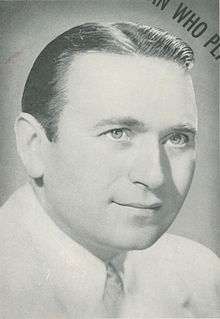Charlie Spivak
Charlie Spivak (February 17, 1905 or 1907 – March 1, 1982)[1] was an American trumpeter and bandleader, best known for his big band in the 1940s.
| Charlie Spivak | |
|---|---|
 | |
| Background information | |
| Genres | Jazz, Big band |
| Occupation(s) | Bandleader, Musician |
| Instruments | Trumpet |
| Associated acts | Johnny Cavallaro Paul Specht Ben Pollack The Dorsey Brothers Bob Crosby |
Early life
The details of Spivak's birth are unclear. Some sources place it in Ukraine in 1907, and that his family emigrated to settle in New Haven, Connecticut while he was a child. Others place his birth in New Haven two years earlier, in 1905. He learned to play trumpet when he was ten years old and played in his high school band, going on to work with local groups before joining Johnny Cavallaro's orchestra.
Big band era and style
He played with Paul Specht's band for most of 1924 to 1930, then spent time with Ben Pollack (1931–1934), the brothers Tommy and Jimmy Dorsey (1934–1935), and Ray Noble (1935–1936). He played on "Solo Hop" in 1935 by Glenn Miller and the Glenn Miller Orchestra. He spent 1936 and 1937 mostly working as a studio musician with Gus Arnheim, Glenn Miller, Raymond Scott's radio orchestra, and others, followed by periods with Bob Crosby (1938), Tommy Dorsey (1938–1939), and Jack Teagarden (1939).
Finally, with the encouragement and financial backing of Glenn Miller, he formed his own band in November 1939.[2] Though it failed within a year, he tried again shortly afterwards, this time taking over the existing band of Bill Downer and making a success of it. Spivak's band was one of the most successful in the 1940s, and survived until 1959. He scouted top trumpeter Paul Fredricks (formerly of Alvino Rey's Orchestra) just as Fredricks left the service at the end of World War II, in 1946. Fredricks was instrumental in the band's success in the coming years as it reached its peak.[3]
Spivak's experience playing with jazz musicians had little effect on his own band's style, which was straight dance music, made up mainly of ballads and popular tunes. Spivak himself (known as "Cheery, Chubby Charlie") had been noted for his trumpet's sweet tone and his strength for playing lead parts, rather than for any improvisational ability. He was also known as "The Man Who Plays The Sweetest Trumpet In The World".
A number of the band's musicians were to make names for themselves, including drummer Dave Tough, bassist Jimmy Middleton, trumpeters Les Elgart and Paul Fredricks, saxophonist Don Raffell, trombonist Nelson Riddle, trombonist Jimmy Knepper, and singers Garry Stevens, June Hutton, Tommy Mercer, Jimmy Saunders, and Irene Daye (who had sung with Gene Krupa, and whom Spivak married in 1950). Riddle was also responsible for many of the band's arrangements, together with Sonny Burke. The late Manny Albam also arranged for the Spivak band.
Later career
When the Spivak orchestra broke up, he went to live in Florida, where he continued to lead a band until illness led to his temporary retirement in 1963. On his recovery, he continued to lead large and small bands, first in Las Vegas, then in South Carolina. In Greenville, South Carolina in 1967, he led a small group featuring his wife as vocalist. She died in 1971 after a long illness with cancer.
During this time, Spivak was also resident band leader for a restaurant-nightclub, "Ye Olde Fireplace", in Greenville, South Carolina.[4] He played trumpet in the dance band that included a drummer, saxophonist, bass player and pianist. The band played standards from the big band era, but also took requests from the audience.[5]
On May 29, 1975, two gunmen entered the restaurant-nightclub after closing for an apparent hold-up. The suspects ordered everyone on the ground. One suspect encountered two band members in the band room, including long-time Spivak saxophonist Angelo "Charlie" Russo were talking. The gunman shot Russo in the chest, killing him.
Spivak continued to play and record until his death.
Family
Spivak's eldest son, the late Joel A. Spivak, was a television and radio broadcaster primarily in the Philadelphia, Los Angeles, and Washington, D. C. areas. Spivak's youngest son, Steven Glenn Spivak, is a public relations manager in northern California. Spivak's Stepson, Kevin Ingram, lives in Greenville, SC and is owner of The Charlie Spivak Orchestra.
Discography
- 1958: Pinciana (Design)
- 1977: Charlie Spivak and His Orchestra 1943–46 (Hindsight)
- 1985: Charlie Spivak and His Orchestra (Ranwood)
- 1993: For Sentimental Reasons (Vintage Jazz Classics)
- 2002: Dance Date (Collectors' Choice)
- 2005: What's Cookin' Charlie '41–'47
See also
References
- CHARLIE SPIVAK (1907-1982), Social Security Death Index
- Yanow, Scott at allmusic.com
- The Big Band Almanac (revised ed.; paperback), by Leo Walker (né Leo Edward Walker; 1910–1995), Da Capo Press (1989), pps. 380 & 381; OCLC 18873553
- Charlie Spivak "Stardreams"
- "Charlie Spivak Settles Down at Fireplace". Reading Eagle (AP Article: Cleveland, SC). 26 December 1976. p. 26. Retrieved 30 April 2014.
External links
| Wikimedia Commons has media related to Charlie Spivak. |
- Charlie Spivak — biography from Solid!
- Charlie Spivak at Find a Grave